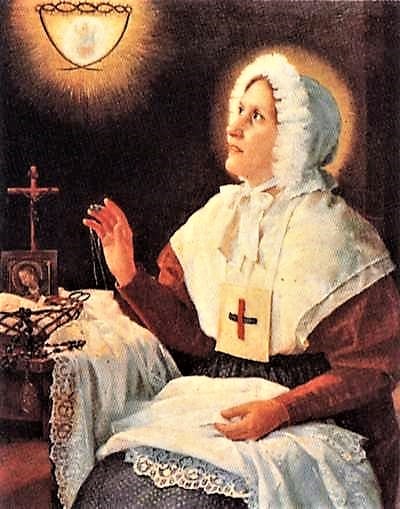
Today, June 9, is the memorial of Blessed Anna Maria Taigi.
Anna Maria was born in 1769. Her father Luigi’s pharmacy went bankrupt when she was five years old. Luigi moved the family from their native Siena to Rome to find work. Anna Maria had no choice but to work to help feed the family.
At age 21, she wed Domenico Taigi, a butler. She was married for 48 years, and a mother of seven, two of whom died very young.
For a working-class woman, Anna Maria was obsessed with her fashion and looks. Home was not peaceful. Domenico had a violent temper and was quarrelsome. One day, while praying at St. Peter’s Cathedral, Anna Maria felt called to ignore worldly things.
Since then, Anna Maria undertook many penances for the conversion of sinners and the intentions of the Church. She became a member of the Third Order of the Most Holy Trinity (Trinitarians), whose rules she followed perfectly.
For years she patiently endured spiritual dryness, performed acts of charity, visited and comforted the sick, evangelized her own family, and inspired them to lead a more prayerful life.
Anna Maria was frequently in ecstasy, worked miracles of healing, foretold deaths, and read the hearts of people. Her simple presence had a powerful effect on many, and she helped with many conversions.
She became counselor to cardinals, royalty, and popes such as Pope Leo XII and Pope Gregory XVI. Among her friends were St. Vincent Pallotti, St. Mary Euphrasia Pelletier, and St. Gaspar del Bufalo.
The most unusual gift God gave Anna Maria was the “mysterious sun” which she first saw after her wedding. The luminous globe maintained a constant position before her eyes. Through this sun, for 47 years, she could see present or future events anywhere in the world as well as the state of grace of individuals, living or dead.
After suffering from painful illnesses, she died in 1837. She was beatified in 1920 by Pope Benedict XV.
Eighteen years after her death, her body was exhumed and was found to be incorrupt. Her body, which is now no longer incorrupt, is publicly displayed beneath the altar of the Basilica of St. Chrysogonus in Rome. Her bones are now enclosed in a figure representing her. The relic’s face and hands are now made of plastic.